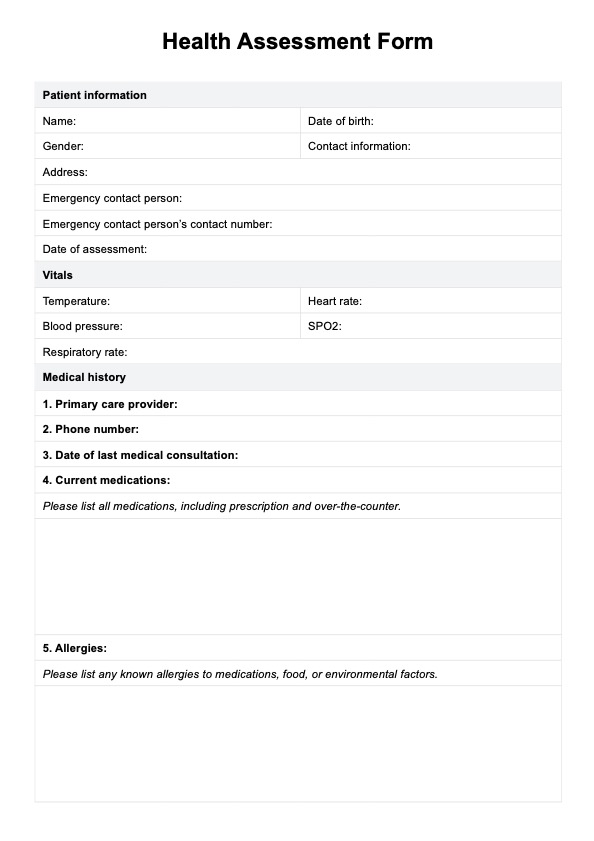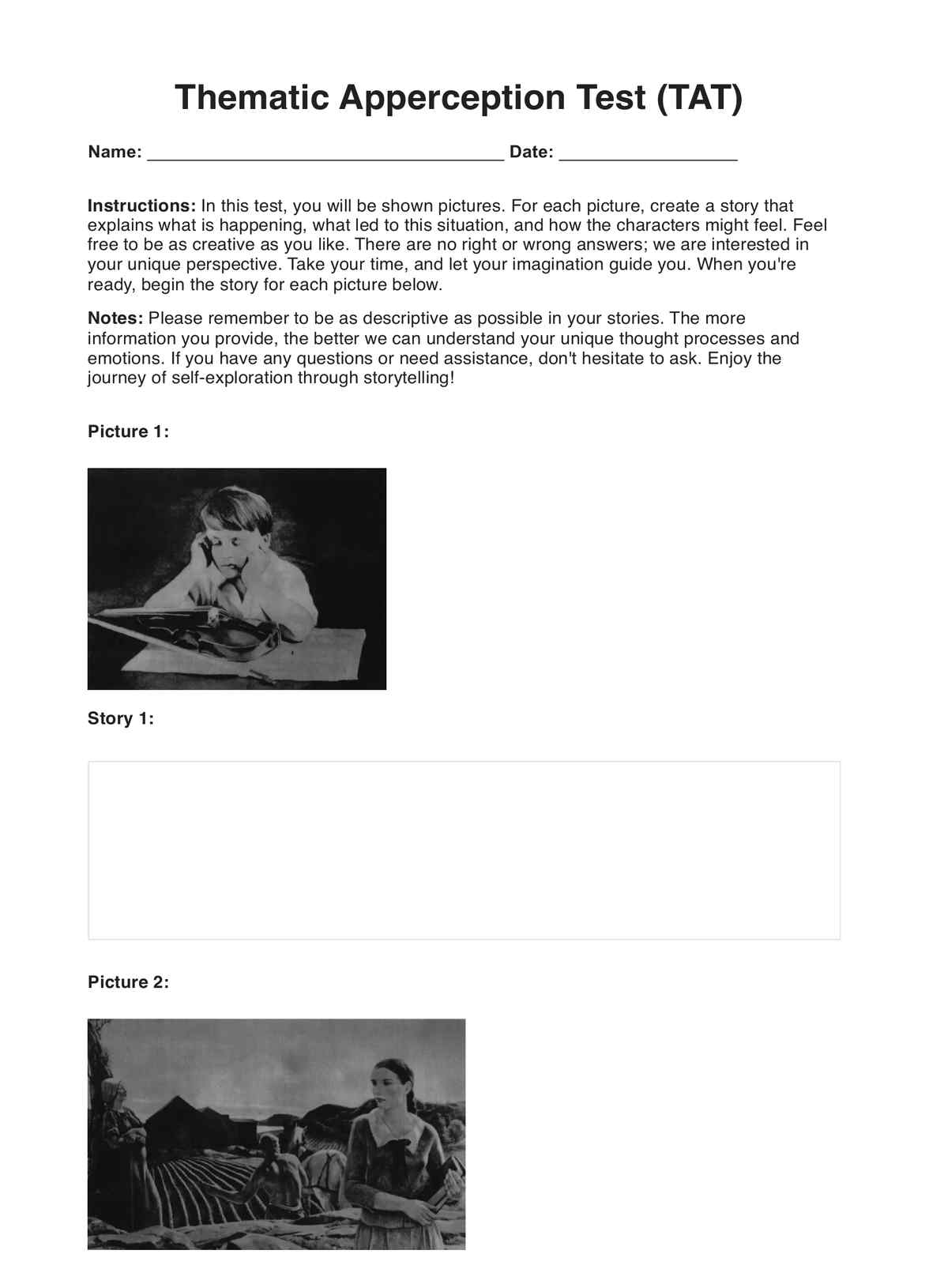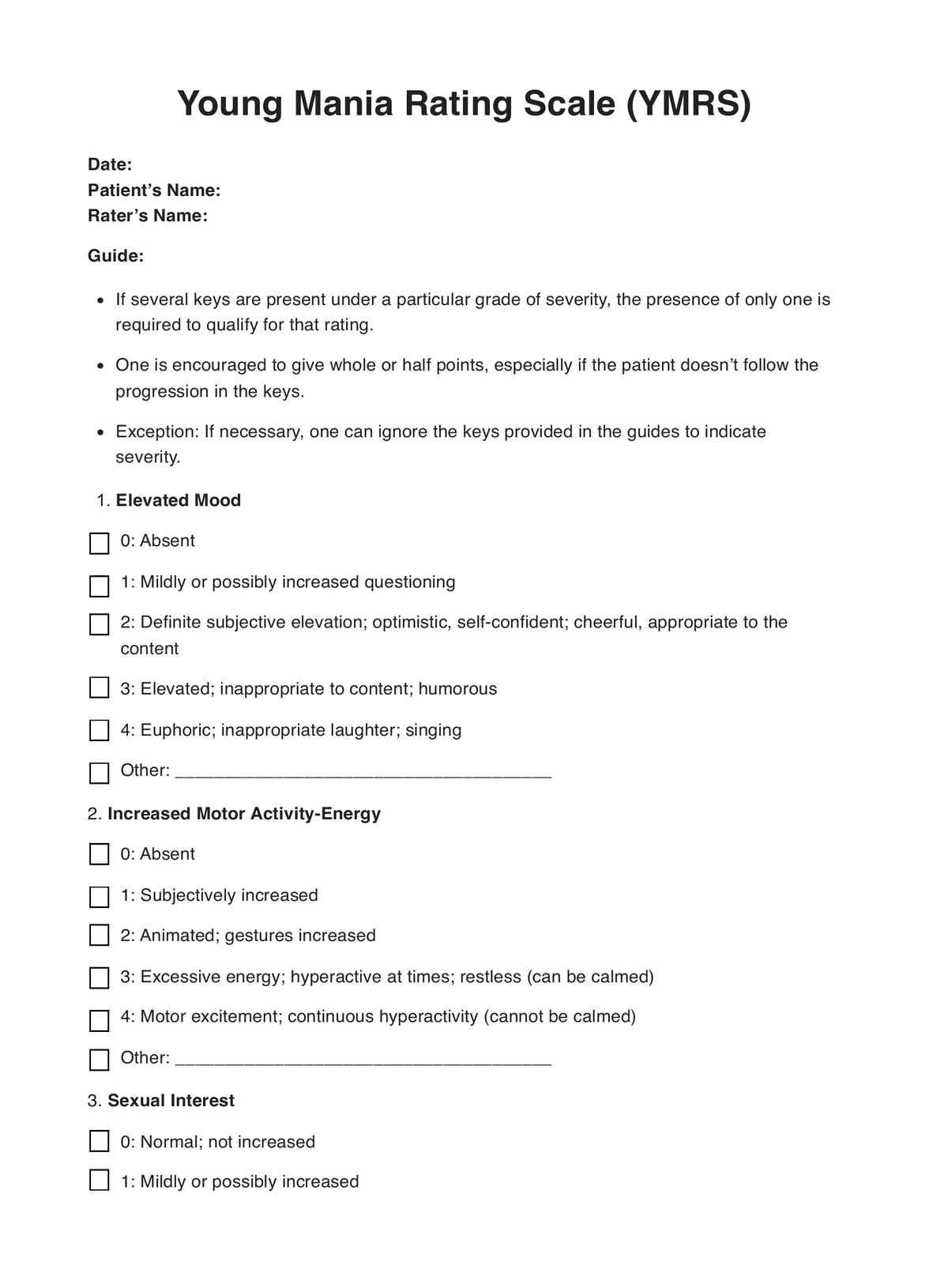Reality Therapy Worksheets
A reality therapy worksheet that empowers clients to gain greater control in their life. This worksheet uses the WDEP model to improve communication, growth, and clinical outcomes.


What is a Reality Therapy Worksheet?
Therapy worksheets refer to resources that are used during therapeutic treatment with a patient. In essence, reality therapy worksheet is a form of therapeutic treatment that is client-centered and focuses on improving current life situations and circumstances, rather than examining past events in detail. Reality therapy often falls under the umbrella of CBT (cognitive behavioral therapy) and it approaches behaviors and thoughts as intentional and changeable. Rather than spending time developing diagnoses, reality therapy encourages patients to focus on taking control over their own life by engaging in informed and useful behavioral patterns.
There are a number of different interventions that are often employed by clinicians specialized in reality therapy, but the most common of these is known as the WDEP model. The WDEP worksheet (wants, doing, evaluation, and planning) encourages patients to explore what they want, consider their current behavioral patterns, evaluate how they are progressing toward their goals, and develop a plan to achieve their wants. Using the WDEP model will empower clients to visualize their own desires and implement realistic and achievable ways to achieve their goals. To help clinicians who specialize in reality therapy, we’ve created a that is based on the WDEP model. The worksheet is the first step in encouraging your clients to change their behavioral and thought patterns. Once complete, the worksheet will provide you and your clients with insight into the client’s desired outcomes and possible ways these goals can be achieved.
Reality Therapy Worksheets Template
Reality Therapy Worksheets Example
How To Use This Worksheet For Reality Therapy
Fortunately, using the reality therapy worksheet follows a very simple process. Some of these steps may seem self-explanatory, but we recommend checking them out regardless to ensure you are making the most of this resource.
Step 1: Access and download the worksheet
The first thing you need to do is access and download the resource. Alongside a completed reality therapy worksheet example, we’ve included a link to the PDF version of the template which can be opened and saved with a single click. You can choose whether to download the worksheet onto your device or if you’d prefer you can also edit the document directly.
Step 2: Give the worksheet to your client
If you are treating a client who you think will benefit from this worksheet, you should distribute it to them. There are a couple of ways that you can do this – either give them a physical copy or send them a link to the electronic version. Both of these options are perfectly fine, but we recommend the latter, as it will enable better organization and compliance.
Step 3A: Client completes the worksheet – Wants
The first part of the worksheet requires the client to record what it is that they want. Encourage your client to visualize the specific goals they are hoping to achieve, and any outcomes that they think therapy will help with. Although solutions should be prioritized more heavily than problems, it is also a good idea to include whatever issue the client is facing in this section.
Step 3B: Client completes the worksheet - Doing
Reality therapy is heavily focused on changing behaviors, and this section of the worksheet targets this. What are the client’s behaviors currently like? You should also encourage your patient to describe their current feelings and thoughts.
Step 3C: Client completes the worksheet - Evaluation
After the client has outlined what they want, and what they are doing, it’s important to evaluate and assess these responses. Does the patient’s behavior align with their goals? Are their goals achievable?
Step 3D: Client completes the worksheet - Plan
Finally, the last section of the worksheet involves the client developing a plan to help them achieve their goals. The plan doesn’t have to be perfect, and this section is more about encouraging the client to start working toward their desired outcomes. After the client completes the worksheet and brings it into their next session, you may decide to alter the plan in order to ensure the goals are as achievable as possible.
Who Can Use this Printable Reality Therapy Worksheet (PDF)?
As we mentioned, the reality therapy worksheet is primarily designed to be used by therapists who specialize in CBT (cognitive behavioral therapy). In regard to patients, there is a very broad range of reasons why an individual may be receiving reality therapy treatment. Some of these include:
- Depression
- Anxiety
- Post-traumatic Stress Disorder
- Financial Stress
- Relationship Issues/Divorce
- Addiction
- Low Self-Esteem
- Phobias
- Grief and Loss
Why is This Form Useful for Therapists?
This reality therapy worksheet has various uses for therapists, including the following:
- Saves time: Because the template is pre-formatted, you won’t have to spend any time organizing the structure. Instead, you simply have to access the only document and edit the worksheet directly. Using this kind of resource is hugely beneficial for both clients and therapists, but having to continuously organize formatting can be a huge time-waster, which you fortunately won’t have to worry about.
- Go paperless: Additionally, this worksheet can be accessed, edited, shared, and stored entirely online, negating the need to have physical copies. In addition to saving you money spent on printing supplies, using the worksheet online will benefit the environment, make organization easier, and ensure you are maintaining compliance at all times.
- Insight into the patient: This worksheet has been designed to be completed by clients, preferably in their own time. This will ensure that the answers they write down are authentic, honest, and genuine reflections of their experiences.
.png)
Benefits of Reality Therapy Worksheet Template
In addition to these uses, implementing the reality therapy worksheet into your healthcare practice will result in many different benefits. Some of these advantages include:
Empower your clients to gain more control in their lives
As we discussed, reality therapy focuses largely on demonstrating to clients how their behavior is intentional and can be changed. By asking clients to reflect on their wants and current behaviors, you will be able to empower them to make positive and meaningful changes that will hopefully contribute to achieving their goals. Negative thinking patterns can quickly become cyclical in nature, and clients struggling with their mental health may find it difficult to break out of these cycles. With an intentional emphasis on altering thought and behavior patterns, clients will be much more likely to achieve their treatment goals and gain control over their life.
Clients can develop more meaningful relationships
Among other things, reality therapy focuses largely on developing meaningful relationships. In addition to strengthening communication between therapists and clients, this type of therapy demonstrates to clients how they can improve the relationships and friendships within their personal and professional life.
More effective treatment plans
This worksheet aims to obtain insight into each client’s personal life experiences, wants, and behaviors. Having access to this data will allow therapists to develop more effective treatment plans that specifically address every objective and desire of each client.
Realistic goals
By emphasizing the intentionality of behaviors, reality therapy encourages the development of more realistic goals. While we can’t help the way that we feel, reality therapy states that we can choose how to think and how to behave. Visualizing connections between thinking, behavioral, and emotional patterns will highlight specific ways that clients can achieve their wants, leading to realistic and achievable goals.
Better clinical outcomes
Ultimately, these benefits will inevitably lead to improved clinical outcomes. Clients can more effectively ascertain what it is they are hoping to achieve and, in collaboration with their therapist, can devise a realistic and goal-oriented way of accomplishing these objectives.
Commonly asked questions
When you use this reality therapy worksheet is entirely up to you. In order for it to be as effective as possible, we would recommend introducing it during the earlier stages of treatment, so the client is able to continuously work toward their goals. It’s also good to remember that treatment plans and general objectives can be fluid, so if a client changes their mind about what they are hoping to achieve, that is perfectly fine.
The reality therapy worksheet that we have designed is separated into different WDEP sections. We have included individual questions within each of these sections that clients should be encouraged to answer. Although the more information and detail that a client includes the better, you may find yourself with a client who struggles to respond to every single question. This is definitely okay, and you should simply encourage your client to write down whatever they can.
The reality therapy worksheet is typically supposed to be completed by the client. However, if you are treating a client who isn’t capable of completing the worksheet by themselves, or perhaps they are simply confused by what the document is asking of them, then you could definitely complete it together. Just try and ensure that all of the answers on the worksheet are authentic and honest reflections of the client’s lived experiences.


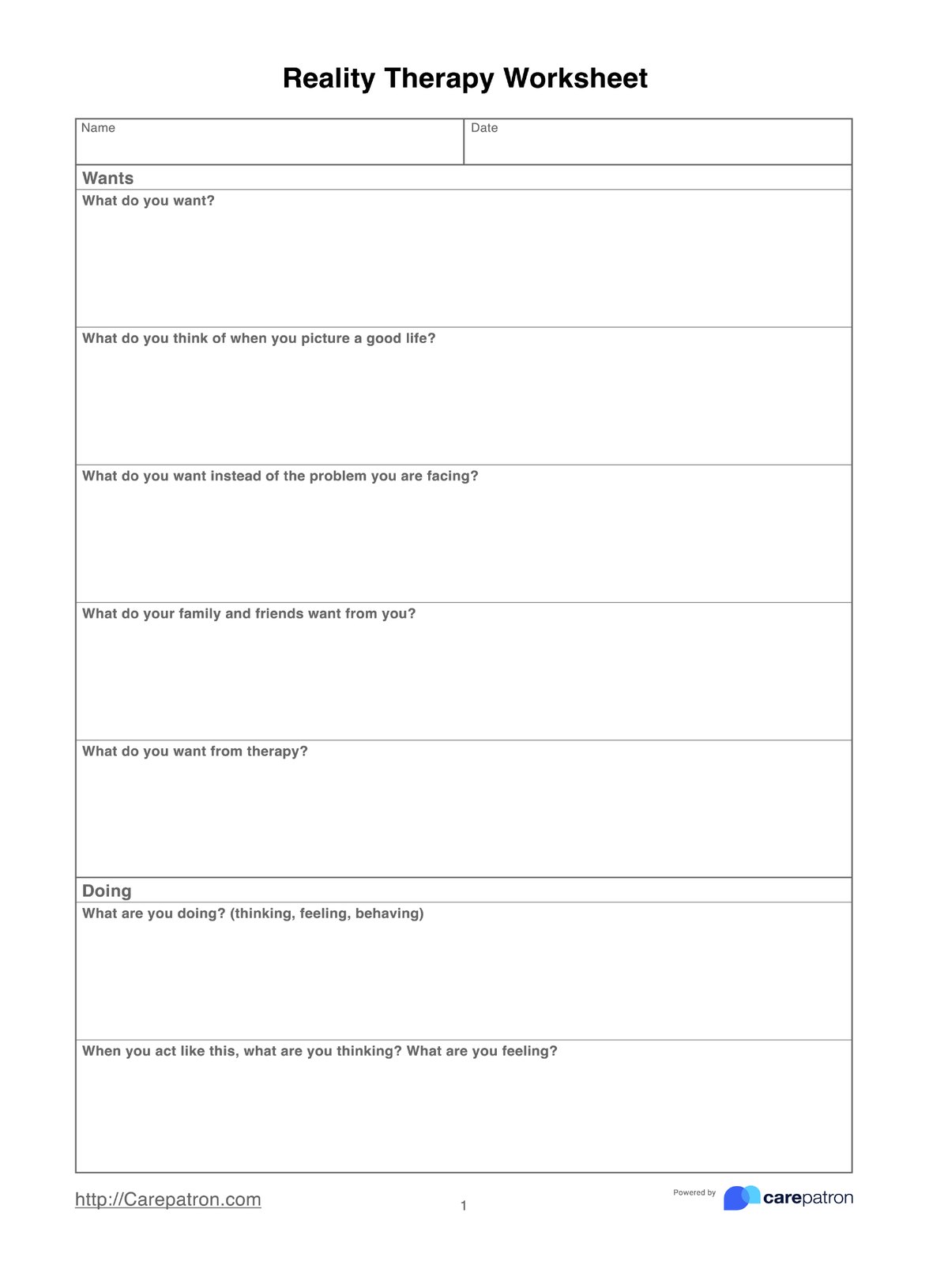
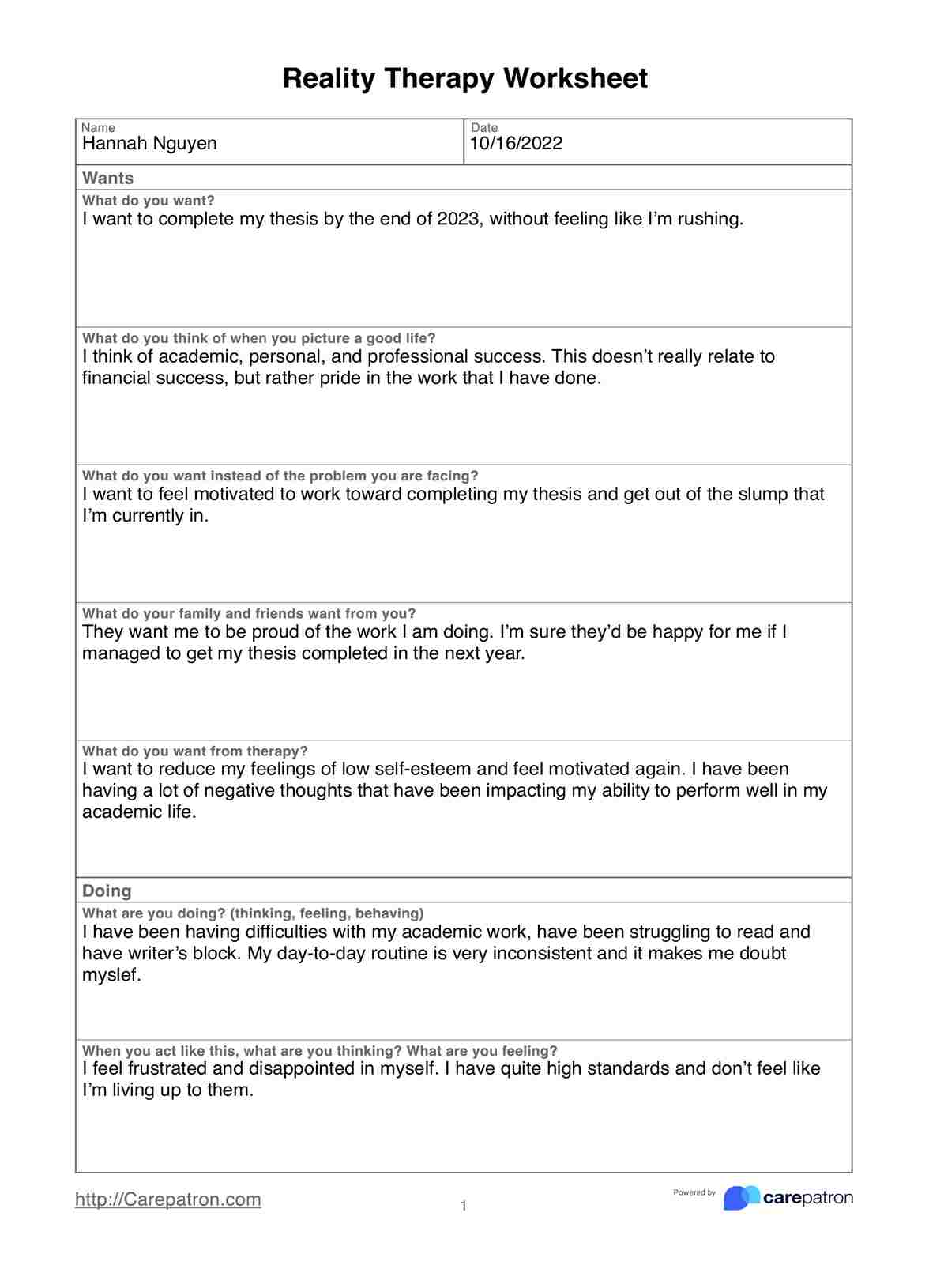

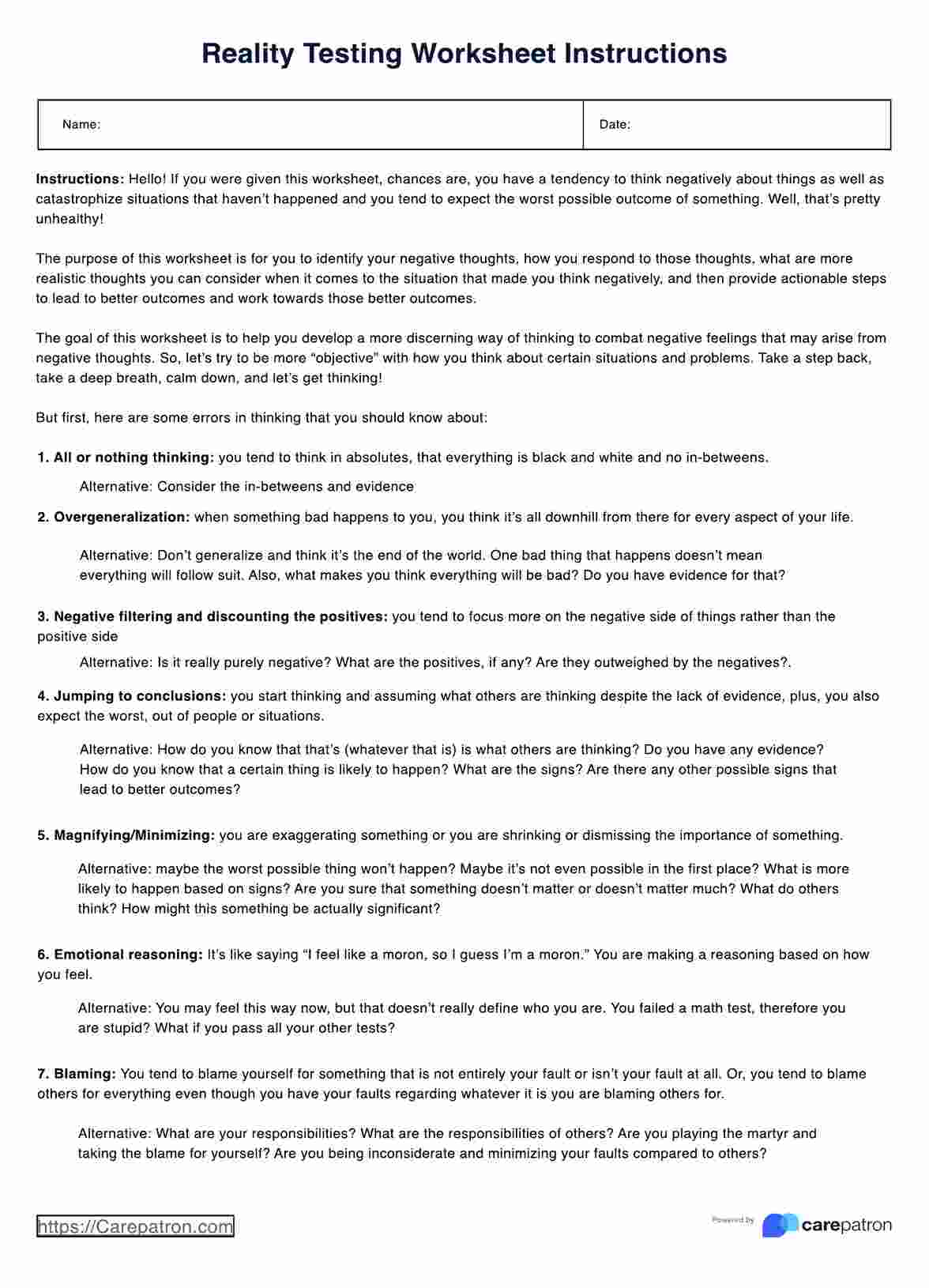














-template.jpg)




























































































